Om du optimerar dina bilder innan du laddar upp dem till WordPress förbättras hastigheten på din webbplats avsevärt. Ändå har många nybörjare långsamma webbplatser helt enkelt för att de laddar upp oupptimerade bilder.
På WPBeginner gör vi bästa praxis för bildoptimering till en del av vår vanliga bloggrutin. Vi ser till att alla våra författare skapar bilder med rätt dimensioner och sedan minskar bildfilstorleken med hjälp av en mängd olika grafikverktyg.
I den här artikeln kommer vi att visa you hur du optimerar dina images för snabbare webbprestanda utan att förlora kvalitet. Vi kommer också att dela med oss av tillägg för automatisk optimering av images för WordPress som kan göra ditt liv enklare.
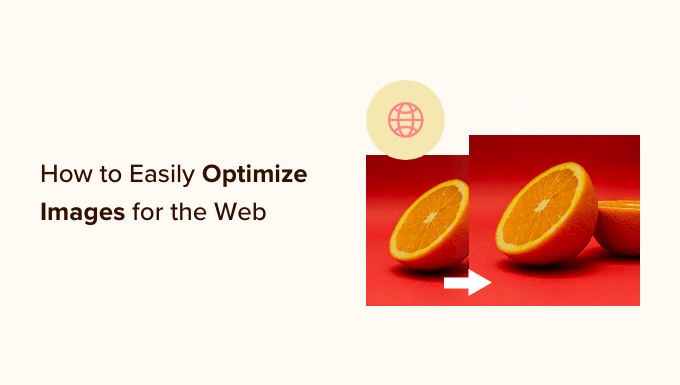
Eftersom det här är en omfattande przewodnik om bildoptimering för webben har vi skapat en innehållsförteckning som är lätt att följa:
- What Is Image Optimization?
- What Are the Benefits of Image Optimization?
- How to Save and Optimize Images for Web Performance
- Best Image Optimization Tools and Programs
- Best Image Optimization Plugins for WordPress
- Final Thoughts and Best Practices for Image Optimization
- Expert Guides on Improving WordPress Performance
1. Vad är optimering av images?
Image-optimering är processen för att save och leverera images i minsta möjliga filstorlek utan att minska den totala bildkvaliteten.
Även om processen låter komplex är det faktiskt ganska enkelt nuförtiden. You can use one of the many image optimization plugins and tools to automatically compress images by up to 80% without any visible loss in image quality.
Här är ett exempel på en optimerad jämfört med en icke-optimerad image:
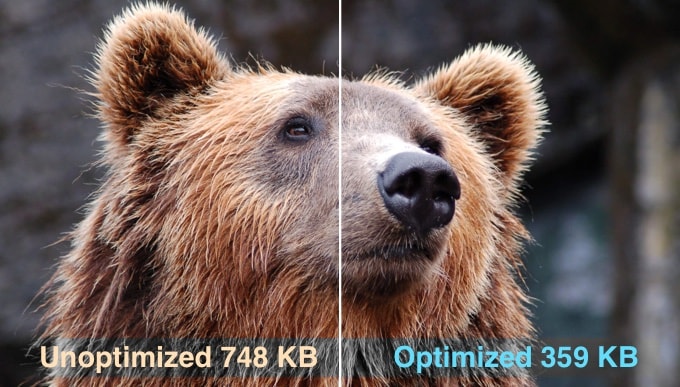
Som you kan se kan samma image, när den optimeras på rätt sätt, vara upp till 80% mindre än originalet utan någon kvalitetsförlust. I det här exemplet är imagen 52% mindre.
Hur fungerar optimering av images?
I enkla termer fungerar imageoptimering genom att använda komprimeringsteknik.
Komprimering kan vara “lossy” eller “lossless”.
Förlustfri komprimering minskar den totala filstorleken utan att kvaliteten på images försämras. Med lossy-komprimering kan det bli en mindre kvalitetsförlust, men helst ska den inte vara notice för yours besökare.
Vad innebär det att optimera images?
Du kanske har fått en rekommendation om att optimera images från ditt WordPress webbhotell eller ett hastighetstestverktyg och undrar vad du behöver göra.
You will need to reduce the file size of your images by optimizing them for the web. Vi visar dig hur du gör det steg för steg.
2. Vilka är fördelarna med optimering av images?
Det finns många fördelar med att optimera dina images, men här är de högst upp som du bör känna till:
- Snabbare website
- Förbättrad sökmotorsoptimering av rankingen
- En högre total konvertering för försäljning och leads
- Mindre lagring och bandbredd (vilket kan minska kostnaderna för webbhotell och CDN)
- Snabbare säkerhetskopiering av websites (vilket kan minska kostnaden för lagring av backup)
Images är det näst tyngsta objektet på en page efter videoklipp. Enligt HTTP archive utgör images 42% av en genomsnittlig web page’s totala vikt.
Eftersom vi vet att snabba webbplatser rankas högre i sökmotorer (SEO) och har bättre konverteringar är image-optimering något som alla företags websites måste göra om de vill lyckas online.
Nu kanske du undrar hur stor skillnad optimering av images egentligen kan göra.
Enligt en studie från Strangeloop kan en sekunds fördröjning av laddningstiden för en website kosta you 7% av försäljningen, 11% färre sidvisningar och en 16% minskning av kundnöjdheten.
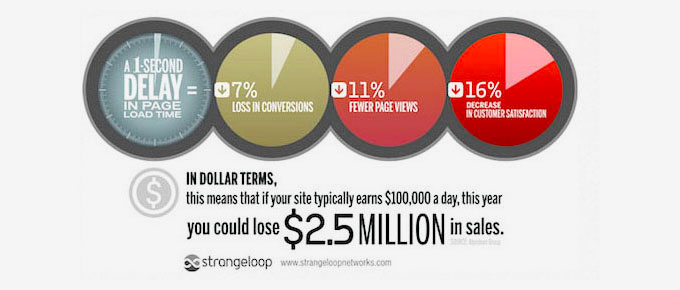
Om detta inte är tillräckliga skäl för att snabba upp din website, så bör du veta att search engines som Google också ger sökmotorsoptimering till websites som hämtar snabbare data.
Det innebär att genom att optimera dina images för webben kan du både förbättra hastigheten på din website och öka sökmotorsoptimeringen i WordPress.
Video Tutorial
Om du föredrar skriftliga instruktioner är det bara att fortsätta läsa.
3. Så här sparar och optimerar du images för webbprestanda
Nyckeln till framgångsrik bildoptimering för webbprestanda är att hitta den perfekta balansen mellan minsta möjliga filstorlek och godtagbar bildkvalitet.
De tre saker som spelar en stor roll vid optimering av images är:
- Filformat för image (JPEG vs. PNG vs. GIF)
- Komprimering (högre komprimering = mindre filstorlek)
- Images dimensioner (höjd och bredd)
Genom att välja rätt kombination av de tre kan du minska storleken på din image med upp till 80%.
Låt oss ta en titt på var och en av dessa i mer detalj.
1. Filformat för images
För de flesta som äger en website är JPEG, PNG och GIF de enda tre format för image-filer som verkligen spelar någon roll. Att välja rätt filtyp spelar en viktig roll i optimeringen av images.
För att hålla det enkelt vill du använda JPEG-filer för foton eller bilder med många färger, PNG-filer för enkla eller transparenta bilder och GIF-filer endast för animerade bilder.
För den som inte känner till skillnaden mellan filtyperna är formatet PNG okomprimerat, vilket innebär att det är en image av högre kvalitet. Nackdelen är att filstorlekarna är mycket större.
JPEG är å andra sidan ett komprimerat format som minskar kvaliteten på bilderna något för att ge en betydligt mindre filstorlek.
Medan GIF bara använder 256 färger tillsammans med förlustfri komprimering, vilket gör det till det bästa valet för animerade images.
På WPBeginner använder vi alla tre formaten beroende på vilken typ av image det handlar om.
2. Komprimering
Nästa sak är bildkomprimering som spelar en stor roll vid optimering av images.
Det finns olika typer och nivåer av komprimering av images available. Settings för varje typ varierar beroende på vilket komprimeringsverktyg som används i din image.
De flesta bildredigeringsverktyg gillar Adobe Photoshop, ON1 Photo, GIMP, Affinity Photo och andra har inbyggda funktioner för bildkomprimering.
Du kan också save images normalt och sedan använda ett webbverktyg som gillar TinyPNG eller JPEGmini för enklare bildkomprimering.
Även om de kräver en viss manuell ansträngning, tillåter dessa två metoder dig att komprimera images innan du uppladar dem till WordPress, och det är vad vi gör på WPBeginner.
Det finns också flera populära WordPress tillägg som gillar Optimole och EWWW Image Optimizer som automatiskt kan komprimera images när du först uploadar dem. Detta är praktiskt och många Beginnare och även stora företag föredrar att använda dessa tillägg för optimering av images.
Vi kommer att delge mer om hur du använder WordPress tillägg senare i artikeln.
3. Imagely Dimensioner
När du importerar ett foto från din telefon eller en digitalkamera har det normalt en mycket hög upplösning och stora dimensioner (höjd och bredd).
Vanligtvis har dessa foton en upplösning på 300 DPI och dimensioner från 2000 pixlar och mer. Medan högkvalitativa foton är väl lämpade för tryck eller desktop publishing, gör deras stora storlekar dem olämpliga för websites.
Om du minskar dimensionerna på bilderna till något mer rimligt kan du minska filstorleken på bilderna avsevärt. Du kan helt enkelt resize images med hjälp av ett bildredigeringsprogram på din dator.
Till exempel optimerade vi ett foto med en upplösning på 300 DPI och image-dimensioner på 4900×3200 pixlar. Den ursprungliga filstorleken var 1,8 MB.
Vi valde JPEG-formatet för högre komprimering och ändrade dimensionerna till 1200×795 pixlar. Filstorleken minskades till bara 103 KB. Det är 94% mindre än den ursprungliga filstorleken.
Nu när du känner till de tre viktiga faktorerna för optimering av images ska vi ta en titt på olika tools för optimering av images för ägare av websites.
4. Bästa verktyg och program för optimering av images
Som vi nämnde tidigare har de flesta program för edit av bilder inställningar för optimering och komprimering av bilder.
Utanför programvaran för bildredigering finns det också flera kraftfulla gratis verktyg för bildoptimering som du kan använda för att optimera images för webben (med bara några clicks).
Vi rekommenderar att du använder dessa tools för att optimera images innan du uploadar dem till WordPress, särskilt om du är perfektionist.
Denna metod hjälper dig att save diskutrymme på ditt WordPress webbhotell account, och det garanterar den snabbaste bilden med den bästa kvaliteten eftersom du manuellt reviewer varje bild.
Adobe Photoshop
Adobe Photoshop är ett premiumprogram för redigering av bilder som låter you exportera images med en mindre filstorlek för webben.
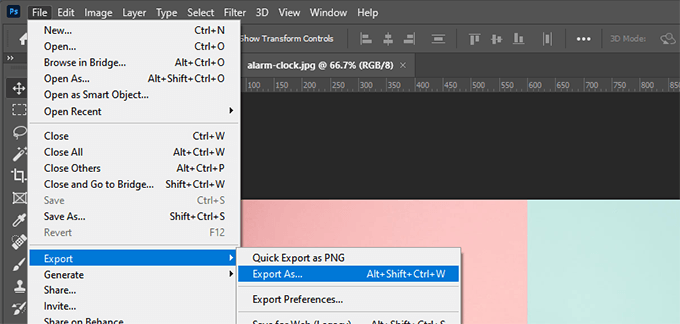
I dialogrutan för att exportera kan du välja det format (JPG, PNG, GIF) som ger dig den minsta filstorleken.
Du kan också minska kvaliteten på image, färger och andra alternativ för att ytterligare minska filstorleken.
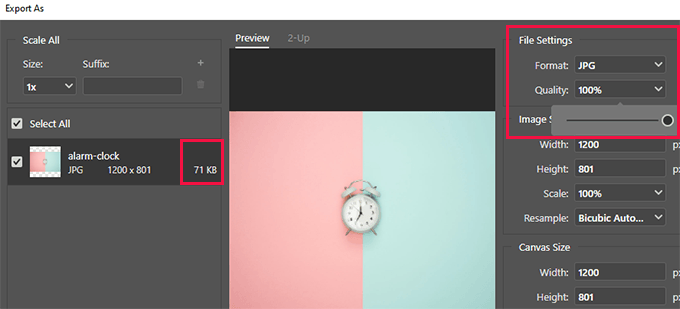
GIMP
GIMP är ett gratis alternativ till Adobe Photoshop med open source. Det kan användas för att optimera dina images för webben. Nackdelen är att det inte är lika användarvänligt som vissa andra lösningar på den här listan.
Först måste du öppna din image i GIMP och sedan välja alternativet File ” Export As…. Detta kommer att visa dialogrutan Exportera Image, där du kan ge din fil ett new namn. Därefter måste du clicka på knappen “Exportera”.
You will now see the image export options. För JPEG-filer kan du använda slidern “Quality” för att välja komprimeringsnivå och minska filstorleken.
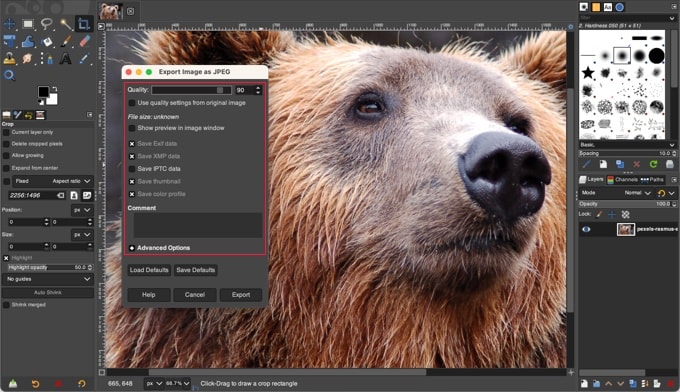
Slutligen ska du klicka på knappen “Exportera” för att spara den optimerade image-filen.
LitenPNG
TinyPNG är en gratis app som använder en smart förlustkomprimeringsteknik för att minska storleken på dina PNG- och JPEG-filer. Allt du behöver göra är att gå till deras website och uploada dina images med hjälp av enkel drag and drop.
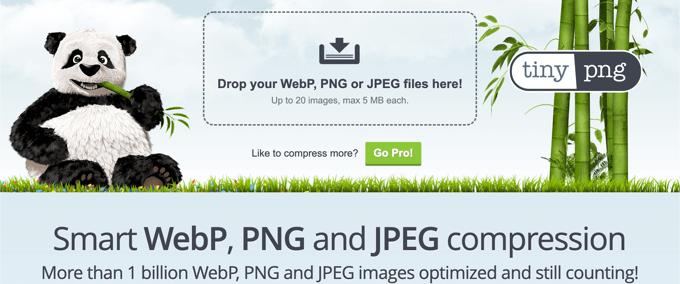
De komprimerar imagen och ger dig en länk till download.
De har också en utökning för Adobe Photoshop, vilket är vad vi använder som en del av vår process för redigering av image eftersom det låter dig komma åt TinyPNG från Photoshop.
För utvecklare har de ett API för att konvertera images automatiskt. För Beginnare har de dessutom ett plugin för WordPress som gör det åt dig. Vi kommer att prata mer om detta senare.
JPEGmini
JPEGmini använder en förlustfri komprimeringsteknik som avsevärt minskar storleken på images utan att påverka deras upplevda kvalitet. You can also compare the quality of the original image and the compressed image.
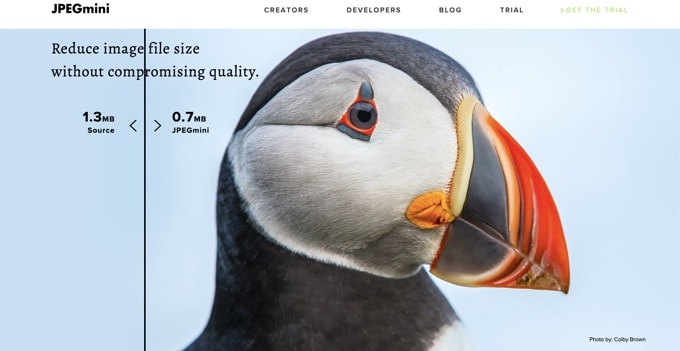
You can use their web version for free or purchase the program for your computer. De har också ett betalt API för att automatisera processen för din server.
ImageOptim
ImagOptim är ett Mac-verktyg som tillåter dig att komprimera images utan att förlora någon kvalitet genom att hitta de bästa komprimeringsparametrarna och ta bort onödiga färgprofiler.
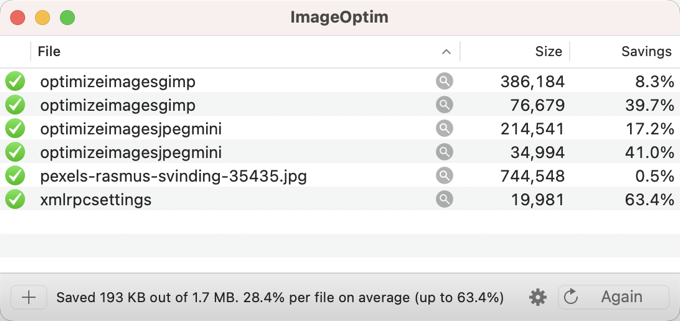
Ett Windows-alternativ till detta är Trimage.
5. Bästa tillägg för optimering av images för WordPress
Vi anser att det bästa sättet att optimera dina images är att göra det innan du uppladdar dem till WordPress. Men om du runar en site med multi-site eller behöver en automatiserad lösning, kan du prova ett WordPress plugin för bildkomprimering.
Här är vår lista över de bästa tillägg för komprimering av images i WordPress:
- Optimole, ett populärt plugin av teamet bakom ThemeIsle
- EWWW Image Optimizer
- JPEG, PNG & WebP Image Compression, ett plugin av TinyPNG-teamet som nämns ovan
- Imagify, ett plugin från det populära WP Rocket-teamet
- ShortPixel Image Optimizer
- Smush
- reSmush.it
- Envira Gallery är ett tillägg för WordPress gallery med built-in komprimering av images
Dessa WordPress tillägg för optimering av images hjälper dig att snabba upp din website.
6. Slutliga tankar och bästa praxis för optimering av Images
Om du ej save images som är optimerade för webben måste du börja göra det nu. Det kommer att göra en enorm skillnad i hastigheten på din site och dina användare kommer att tacka dig för det.
För att inte nämna, snabbare webbplatser är bra för sökmotorsoptimering, och du kommer sannolikt att se en ökning av din search engine ranking.
Bortsett från optimering av images är de två saker som kommer att hjälpa dig att snabba upp din website att använda en WordPress caching plugin och använda en WordPress CDN.
Alternativt kan du använda ett hanterat WordPress webbhotell eftersom de ofta erbjuder både caching och CDN som en del av plattformen.
Expertguider för att förbättra WordPress prestanda
Vi hoppas att den här artikeln hjälpte dig att lära dig hur du optimerar dina bilder i WordPress. Du kanske också vill läsa några andra artiklar om hur du kan förbättra WordPress prestanda:
- Den ultimata guiden för att öka hastigheten och prestandan i WordPress
- Hur man snabbar upp WooCommerce prestanda
- Så här avlastar du WordPress Media för att förbättra webbplatsens hastighet
- Bästa tillägg för caching i WordPress för att snabba upp din website
- Hur man optimerar Core Web Vitals för WordPress (Ultimate Guide)
- Så här minskar du tiden till första byte (TTFB) i WordPress – Experttips
- Så här använder du tillägget GTmetrix för att förbättra prestandan på din WordPress site
- Snabbaste webbhotell för WordPress (prestandatester)
- Viktiga metrics att mäta på din site i WordPress
- Hur man korrekt run testar hastigheten på en website
- Så här stresstestar du en website i WordPress
If you liked this article, then please subscribe to our YouTube Channel for WordPress video tutorials. You can also find us on Twitter and Facebook.





Diane Talbotier
Hi, does resizing mean changing the size of the images as they are shown on the website, or resizing the size of the file , please?
And how do I know what is the optimal size?
WPBeginner Support
It would depend on what you mean, for compression in this guide, it is the size for the file. You can also reduce the width and height of an image if it is too large. Your specific theme would determine the specific image size you want to use.
Admin
Terri
You mentioned in your optimise example that your original photo was 300dpi, then you optimised it to a smaller file size. But you did not say what the target dpi was. Is it 72 for web? Or higher? Thanks for the informative article.
WPBeginner Support
That would depend on your personal preference and how large you are wanting/needing the images to be.
Admin
Romel
thanks a lot it cleared a lot of doubts.
WPBeginner Support
Glad our article was helpful
Admin
Odenyi Emmanuel Chidera
What I like most about wpbeginner is how they will give you information on what to implement on your own site but also tell you what they are using on their own site. It really helps me decide faster. Learning from a master is always easier. Thanks.
WPBeginner Support
You’re welcome, glad you like our content
Admin
Luz Manalo-Cruz
I’ve compressed images via TinyPNG and tried to replace the heavier images on my site with these (ie. I deleted the heavy photos and uploaded the compressed ones). However the media library is still uploading the old heavier images. Does that mean that I can’t replace the old images already uploaded? Will it only upload the compressed images that have not been uploaded at all?
WPBeginner Support
If you are replacing the heavier images, you would want to ensure you don’t have caching on your site that is showing the old image and when you upload the new image that you are uploading the correct image.
Admin
Giovanna
Thanks for the informative article, Syed.
Moving forward I am going to make sure to always use optimized images. Do you recommend I go back to already published posts and replace my images with optimized ones?
WPBeginner Support
If possible we would recommend updating your older images, the plugins we recommended should handle that for you
Admin
Percy Young
Thank you for your post. many nice tools. I wonder if theres any thing to be done to rezize images that have been previously uploaded, and how to delete images the worpress is not using any more.
WPBeginner Support
If you need to generate new images you could follow our guide here:
https://www.wpbeginner.com/plugins/regenerate-thumbnails-new-image-sizes-wordpress/
For removing the extra images there are media cleanup plugins that you are able to use
Admin
WPBeginner Support
Glad you’ll use our recommendations
Admin
Dr Amandeep Sandhu
Thanks for sharing such ideas….!
WPBeginner Support
You’re welcome, thanks for reading our articles
Admin
İbrahim BOZKURT
I’m a WordPress developer. I am writing from Turkey.
Very difficult to find quality WordPress resources.
I discovered you. I didn’t know English but learned English. Thanks to you everything.
WPBeginner Support
Thank you for reading our articles and congratulations on learning a new language
Admin
Felipe Adan Lerma
Hi, it seems maybe WordPress has incorporated some of this into its current image upload process, at least in the Premium bracket?
I ask cause I now get the option to choose the actual size or something larger or smaller?
Or is that process not an optimization / reduction in size of the image?
Thanks so much! Very important useful topic.
Adan
WPBeginner Support
It sounds like you may be talking about WordPress.com and they have custom plugins setup for sites on their service
Admin
Felipe Adan Lerma
Ahhh, yes, I forget the two WP’s differ, sorry. I’m still trying to figure out how to work where I am w/WP & it’s definitely via their .com sites. Thank so much then, WP – Adan
WPBeginner Support
No worries, should it help we have our article listing the differences here:
https://www.wpbeginner.com/beginners-guide/self-hosted-wordpress-org-vs-free-wordpress-com-infograph/
Anna
Very helpful info!! I was just researching how to do this when your email came through! Saved em time and effort and had just the advice I was looking for.
WPBeginner Support
Glad our guide and newsletter could be helpful
Admin
Lindsay
When saving on photoshop what width do you suggest for optimum web performance?
My theme is saving 1600×1050 for optimum header but what should I do for the body images. Theme designer doesn’t have a recommendation.
WPBeginner Support
If you’re going through the other steps in this article then the image size would be what would fit your content’s dimensions best so WordPress wouldn’t need to resize the image.
Admin
edccde
Please update that youtube video.First of all Jpegmini isn’t a web app and it is a software which i have to install in my pc.
WPBeginner Support
Thank you for letting us know about the video, we’ll certainly look into updating the video
Admin
Jackie
Is there way to compress images already uploaded to wordpress? Or do I need to compress all my images and then reupload into WP? THanks in advance for the advices.
Irina
Hi,
Need an advice: I need to upload Low res and Hi-res images (1200pix at 300dpi) so my customers can download them. I have no questions about LR image optimization. How can I save hi-res images? The size is up to 2 MB. I have hundreds of thousands of images…
Ratan Kumar
This post is awesome and really add value to my site. However, I recently tried to save images from flipkart but it saved in very low pixel format. Wondering if you can help me to figure out on how to do that.
Ray
I already bulk uploaded 1500 product images that were connected to image urls I found on the internet.
Now that I have those 1500 images already in my Media Library, how can I go back and resize and compress them?
Also, I’m confused about whether resizing means changing the size of the images as they are shown on the website, or resizing the size of the file.
Thanks!
Sara Lewis
what about the plugin ewww image optimizer?
WPBeginner Support
Hey Sara,
Yes its a good alternative. However, for better results we would still recommend optimizing images in your image editing program before uploading to WordPress.
Admin
Donna
I will be travelling to a place where internet connectivity is limited and expensive. So, I want to reduce the file size of my photos before I go online to upload them to my blog. Can someone please recommend for me what resolution and dpi would be good to use? The app I am planning to use asks for three measurements:
resolution – from 200 to 2048
DPI – from 72×72 to 300×300
jpeg quality (compression level) – from 0.00 to 1.00
Carrie
In the video she changes her pic. I understand the screen in PS. But you have not explained what should the width and height be in pixels for WP the limit is 2mb. What would be a good standard for sliders, etc for a wp site?
Carrie
Sorry for being the dunce in the corner, but could someone please clarify one thing? I installed the WP Smush it plugin and have been slowly working through all the photos I’ve uploaded to my site for the last 2 years. I’m doing 50 at a time, the free limit. However, now that I have the plugin, for future photo uploads, does having it mean I don’t have to use any other program to resize my photos before uploading them to my WP site? If I have an 8 MB photo and upload it to my site, the plugin does everything for me? I just want to confirm that the original photo is not still uploaded and saved to my host server, SiteGround. My site is wicked slow, I’ve run tons of diagnostics, and I still can’t figure out why except that everything points to my photos. Thanks!
Tony Squibb
Hi Carrie, I’m defo not an expert in any way but I do have experience with WP Smush it and yes, future uploads should be auto ‘smushed’. There is a little notification in the media gallery as you do so.
To check the causes of your slow site you can use GTmetrix and then open the waterfall page where it will show the times of the individual pages items loading. Once you know what is the problem you can then address it.
I hope that helps from one ‘dunce’ to another
Carrie
Hi Tony,
Thanks for weighing in! Unfortunately I uninstalled WP Smush and tried EWWW Image Optimizer along with the Thumbnail Regerate plugin (based on another bloggers suggestion) and royally messed up the photos on my site. I’m a newb with regards to how to manage my files through the FTP on my web host, so I ended up deleting a bunch of images (as in hundreds) and re-uploading them after resizing them manually in an image program. Turns out that too was a bad idea. Now I have a bunch of error messages when I render my site in my Google Console because when Google crawls my site, those files are now gone or moved. AGH! I’m on the verge of simply paying someone to revamp my site or quitting altogether. But I really appreciate that you took the time to leave a helpful comment.
Happy New Year! May 2017 be better than 2016.
Jeff
hi
Best Image Optimization Plugins for WordPress Site Which is?
Gagan
I was thinking what if i upload my Images to Google Blogger and use them on my wordpress Site by “Insert From URL” option?
Any suggestion if this is a Good Idea or no?
Thanks in advance
Zimbrul
I came back here as I’m looking for plugins that upload a large image as a optimised image straight to WordPress. I’m sure I’ve seen this somewhere here at WP Beginner but I cannot find it.
WPBeginner Support
Please take a look at Optimizing images with WP Smush pros, cons, and alternatives.
Admin
Jack
Photoshop is definitely the best one, for online services, kraken.io and resizeimage.net are good alternatives to tinypng.
tanveer
is xnview a good option for compressing images?
WPBeginner Support
We haven’t tried it.
Admin
Larry Aldrich
Someone mentioned RIOT in an earlier comment. It is my go-to app for minimizing images BEFORE you upload them. The compression rate is close to phenomenal. Sorry MAC users, but it’s only available for Windows.
Martin
Hello WPBeginner,
I would be very interested in the Windows version of Trimage you have apparently seen.
On the Trimage homepage you just see a link asking for help with the windows port…
Greg
I have got used to using Fireworks even though I have CS3
Zimbrul
Me too. I use CSS4 and still go to Fireworks for image optimisation.
Marianne P.
I just checked out the Trimage site and did not see the Windows version – just various *nix versions. Please point me in the right direction. Thanks so much – really great article!
Corinna
I was wondering if there was any way of reducing the size of the images already uploaded to a site? I have changed the way I upload them so in future all my images will be smaller. But I thought maybe it would be useful to change the size of those already uploaded.
Julie Anglesey
I would also like to know how to reduce the size of images already uploaded.
Zimbrul
It’s (or was) Smush-It.
Samiullah Khan
Search the web too much to find good solution to optimize images; but most of them most of them doesn’t let’s see tools mentioned in this post work or not
Graham
The article defines PNG as an uncompressed file format, but as far as I know, standard PNGs use lossless compression.
And I think it would be helpful to mention why you might choose one format over another for continuous tone images (eg. a photo) vs. limited palette images (eg. a logo).
Rob Dewing
Why no mention of Photoshop Elements, the cut down home use version of Photoshop? It does 90+% of the things full phat Photoshop will do, including ‘save for web’ image compression, all for less than $100.
Ines
Would you recommend to use Flickr to upload your images and then copy the HTML code to your wordpress site? What would you suggest for travel blogs that contain lots of pictures? Thanks.
WPBeginner Support
You can add flickr photos in WordPress by simply pasting the photo URL in a post. Normally we would not recommend it, because people will be viewing and finding your photos on Flickr and may never even get a chance to visit your website. However, if you feel that building a community around your photos on flickr is more useful for you, then sure go ahead.
Admin
Benjamin
You could add kraken.io to your list. It does the same thing as Jpegmini but also works with PNG images.
Aurel
I am using RIOT, which is free, very fast and exelent program.
Debra Torres
I’ve been using the Yahoo Smush it tool at: http://www.smushit.com/ysmush.it/
Would you recommend this one? Or are the others you mentioned better?
WPBeginner Support
Smushit is a great tool too. But try other tools we mentioned and compare the results.
Admin
James DiGioia
There is WordPress plugin for Smush.it:
http://wordpress.org/plugins/wp-smushit/
This makes it easier to compress images using Smush.it without having to prep them beforehand.
Youri van Dijk
I was about to mention that plugin as well. I generally do save my images optimized myself, but for clients that are not very familiar with these tools installing the plugin is a huge benefit.
John Mauldin
Your article is VERY timely. Just encountered the need to reduce hundreds of photos for a kitchen and bath showroom. Bought JPEGmini since I could only do 20 photos a day in the free version but $19.99 is nothing for the ability to drag and drop entire folders into the program and have it zip them in seconds/minutes. Thanks so much for the help!
Haseeb
Isn’t there any automated way of doing this on wordpress? How about ‘WP Smush.it’ ?
Editorial Staff
You can automate the process with some tools that we mentioned or using this plugin:
http://wordpress.org/plugins/ewww-image-optimizer-cloud/
But why create more server load when this can be resolved by educating the user.
Admin
Marlene
Great article, however I was under the impression that any images with text on them should be saved as PNG files for best sharpness….?
Editorial Staff
PNG will definitely have a higher quality, but most folks won’t be able to tell the difference unless you put them side-by-side. If you can speed up your site with a non-noticeable difference, then why not
Admin
Adam W. Warner
Great article, and an important subject many WordPress admins miss.
[Link Removed]
Lynn
Lightroom has a number of presets for exporting to Facebook and Web – do those compress the photo files sufficiently or should I still turn to Photoshop?
Editorial Staff
Not sure about lightroom and how it exports image. You can run a side-by-side test.
Admin
Graham
Lightroom will do pretty much the same job as Photoshop when exporting photos to JPEGs.
Bill Wells
Lightroom is the go-to for photographers; it allows you to optimise your photos in batches and then will export the batch to your preferred pixel size and compression in a number of formats, including jpeg. It also automatically adds your copyright message to the batch if you want.
I don’t know about batch-processing in Photoshop but I use it for major image manipulation only.
I guess if you’re doing graphics or heavy manipulation, use Photoshop but if you’re using lots of photos and just want them to look their best, use Lightroom.
Scott Wyden Kivowitz
I’m a big advocate for many of the products you mentioned. Now I get to add this link to my resources for whenever customers ask me this exact question. Thanks Syed.
Editorial Staff
You’re very welcome Scott.
Admin
Dave Kulas
If you are taking the pictures yourself for your website …. set your camera to take a picture at 800 x 600 and at less resolution. Some camera have a Good – Better – Best resolution setting … use the “GOOD” setting. . You should get an image that will load quickly.
If you already have some images … take a look at for FREE … http://www.getpaint.net ….. I have been using it for years. I take the HUGE photos given to me by clients … then RE-SIZE them to 800 x 600. Then I use the built in compression tool to compress the image.
Steven Alig
I would not recommend taking low resolution photos.
You will want to take your original photos at higher resolutions just in case you want to use them for something else. Plus if you take photos at a higher resolution, you will have the ability to crop in on an area if desired.
If the photos are a lower resolution, you will not have that option and will be stuck with what you have taken as the original.
Mark Pridham
I have to agree with Steven on this. I highly recommend taking high resolution images in your camera. You then have a large file that you can work with, It very easy to reduce file size from a hi-res image, but impossible to go the other way. By taking hi-res images, you also have the option of using them for print work if the need arises, Generally, I end up with the large, raw image, a cropped and retouched print image, and a smaller image for web-based work.
Michael Maye
I would agree too about taking full high resolution photos. Then resize down and compress for uploading to your website. You will always have the original high res photo for other uses.
Zimbrul
I usually use Fireworks and then Tiny PNG if required.
Editorial Staff
Yup that’s a good combination
Admin
Geoffrey Gordon
Great article Syed.
However I really think that fireworks is the king when it comes to optimising images for the web and its a whole lot cheaper than Photoshop.
Editorial Staff
Thanks Geoffrey. Yup I know Photoshop is expensive which is why I mentioned other free tools as well. GIMP and Fireworks both has this functionality.
Admin
paul
So I’ll just follow the options as seen on the image in this article’s Photoshop section and it’s all good?
Editorial Staff
Yup, if you do that, then you will have probably one of the best performance results. However depending on an image, some might not look as good, so in those cases we try the Very High. Do it on case by case basis, but most images would be fine.
Admin
Andrew Brown
You discuss using Photoshop, which is way beyond most bloggers needs or price – why do you not refer to Lightroom, which also has an excellent image export option, including an option to restrict the max file size, as well as save by dimension or using a set dpi.
Once some one knows the comp screens work at 72dpi, the rest becomes much easier, and it becomes amazing as to how easy it is to have a web template amongst the export options without needing any real in depth knowledge of what needs to be done.
Editorial Staff
Andrew,
Yes we understand that Photoshop is expensive which is why we mentioned several other free options. Just updated the article now to add a link to GIMP right below photoshop.
As for Lightroom, didn’t mention it because we don’t use it. Same reason why Fireworks was left out.
Admin